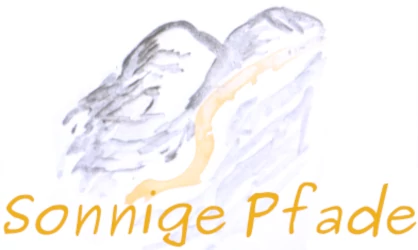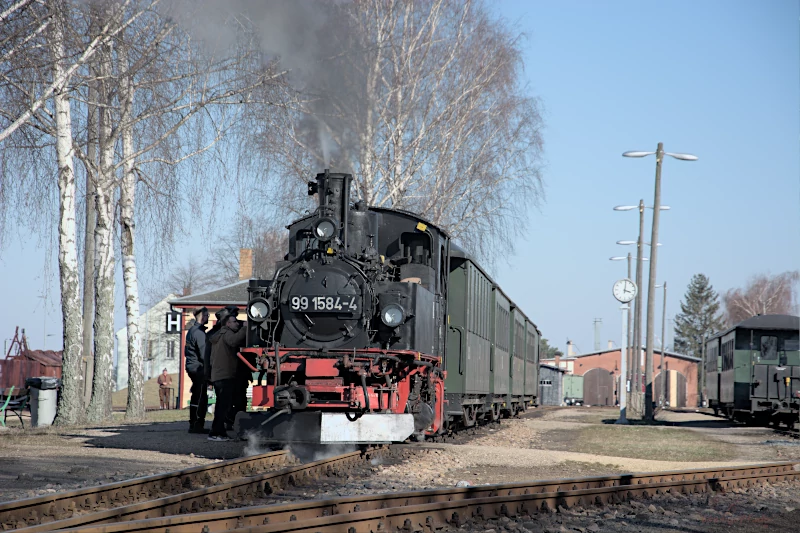
In east german Saxony there are several narrow gauge railroads, on which mostly still historical steam locomotives pull a train of old second and third class coaches. Often the lines are located in the low mountain ranges such as Cranzahl to Oberwiesental on the Fichtelberg mount or in the Zittau Mountains to the resorts of Oybin and Jonsdorf. The northernmost of the Saxon narrow-gauge railroads, however, runs more in the lowlands – that is the Döllnitz Valley railway „Wilder Robert“ (wild Robert) from Oschatz via Mügeln to Glossen or Kemmlitz. Located between Leipzig and Dresden in Saxony, it is an attraction for steam locomotive and railroad nostalgics, especially on „steam weekends“.
[Contains *advertising]
The „Wild Robert“ – the Döllnitz Railway invites you to a steam train ride
Conveniently, the Döllnitz railway, which locals like to call „Wilder Robert„, is connected to the regional railroad network. Anyone traveling on the Saxony magistrale from Leipzig to Dresden can leave the standard gauge railway in Oschatz and switch to the third platform. There begins the track of the narrow rails – eastern terminus of the Döllnitz – Railway with 750mm gauge.
The line first winds through Oschatz, meets the small stream Döllnitz, which is name-giving and course-determining at the same time for the „Wild Robert“ narrow gauge railroad. This is because in the pioneering years of the railroad, the lines were very often planned and built along rivers – the river valleys opened up the region with low gradients up to the heights of the mountains. Besides, people preferred to settle along rivers anyway, the power of water was used for crafts and industrial plants. Consequently, there were both the largest number of passengers and the most goods and merchandise to be transported along the river valleys – so one thing led to another.
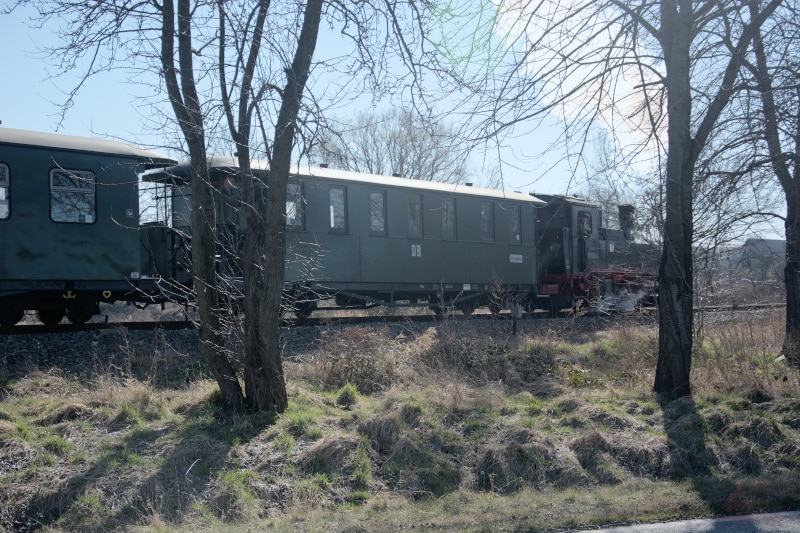

From Oschatz to Mügeln on narrow gauge
The Döllnitz railway crosses the stream on a long bridge parallel to highway 6 and bypasses the old town center of Oschatz for quite a distance. One stop for this is in Körnerstraße. Then it goes past the fun spa Platsch and through the grounds of the former state horticultural show, where another stop is „Oschatz Süd“.
Behind it it becomes more rural. The route follows the Döllnitz River in wide arcs between flat hills. A piece of floodplain landscape with meadows and alder-lined watercourses opens up. Other stops with „demand stops“ such as Kleinforst Rosensee or Thalheim Kreischa lie in between. Then, increasingly, fields of the surrounding farms follow, between which the narrow-gauge tracks run. In view of the huge industrial farmland, the narrow-gauge railroad seems a bit out of time. At Schweta, the Döllnitz railway and Döllnitz stream meet again.
Here, the small town of Mügeln announces itself with some industrial estates next to the railroad facilities. Parallel to the main road, the railroad rolls another kilometer , then in a curve around its own locomotive sheds to reach the station Mügeln.
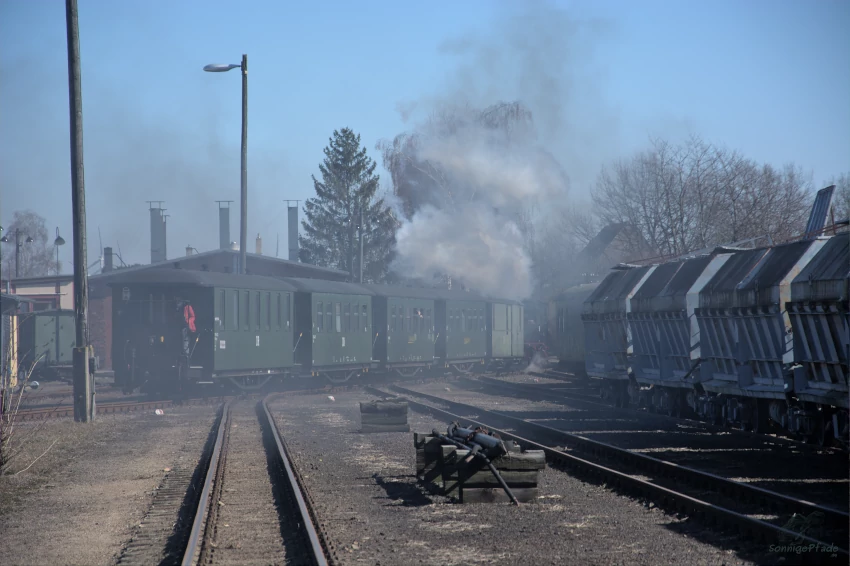
Mügeln station – large station for narrow trains
This station is the real heart of the Doellnitz railway. Once one of the largest narrow gauge stations in Europe, it is the home station for all trains on the line. Logically, it also includes the locomotive shed, coal yard, various track fields and the station itself.
If the train has already completed a full round trip, the „coaling“ of the steam locomotive as well as the „water – fetching“ at the water crane are part of the stop. This means that there is a longer break (2:20 to 3:00p.m.) at Mügeln station, which can be used to observe the various supply activities around the steam locomotive. Good time for fotographers! The locomotive is uncoupled, moves to the coal yard, the tender is filled with new coal. All done by hand. Then the locomotive has to be shunted to another track to be filled with water at the water crane. Along the way, various minor maintenance tasks are carried out – the gem is obviously in loving hands!
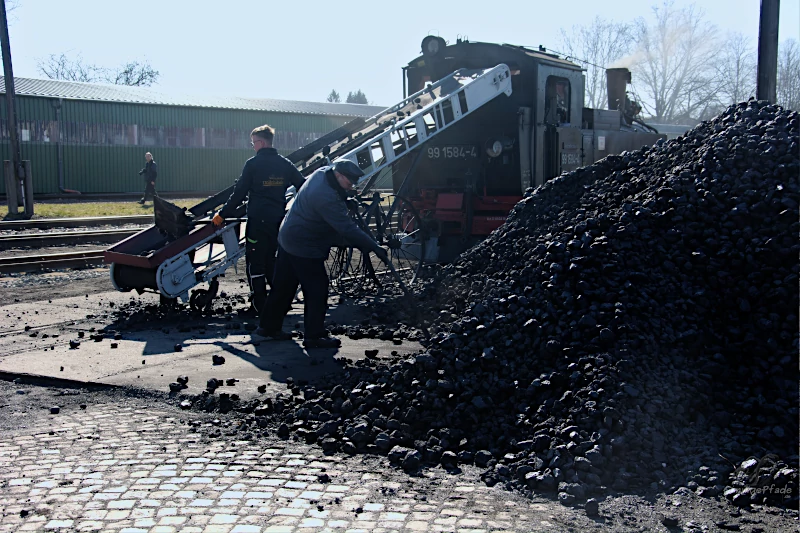
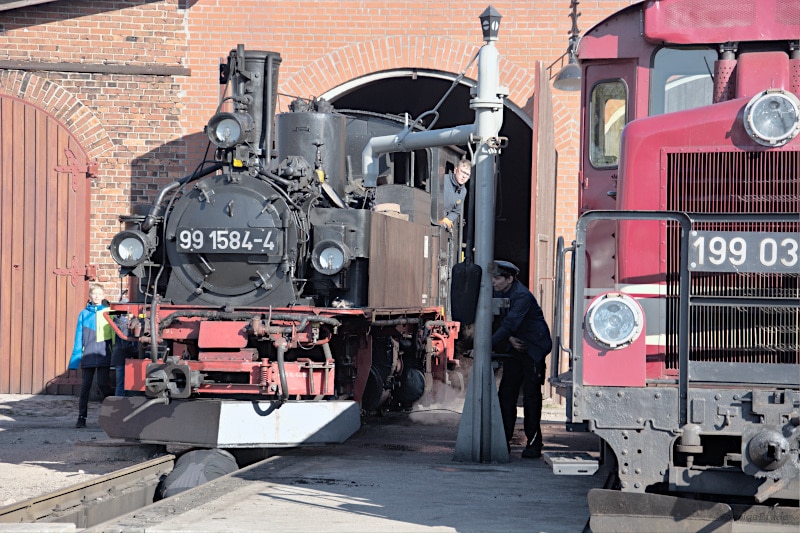
As a light rail through the floodplain – Park
When the steam train ride continues, the Döllnitzrailway first crosses the main road at the western exit of Mügeln station and disappears between old industrial buildings into the Döllnitz floodplain. There, on the edge of the old town of Mügeln, it passes Ruhethal Castle with its thick tower and the town center. Twice there is still the possibility to get off or on – at the stop Mügeln – town and Altmügeln.
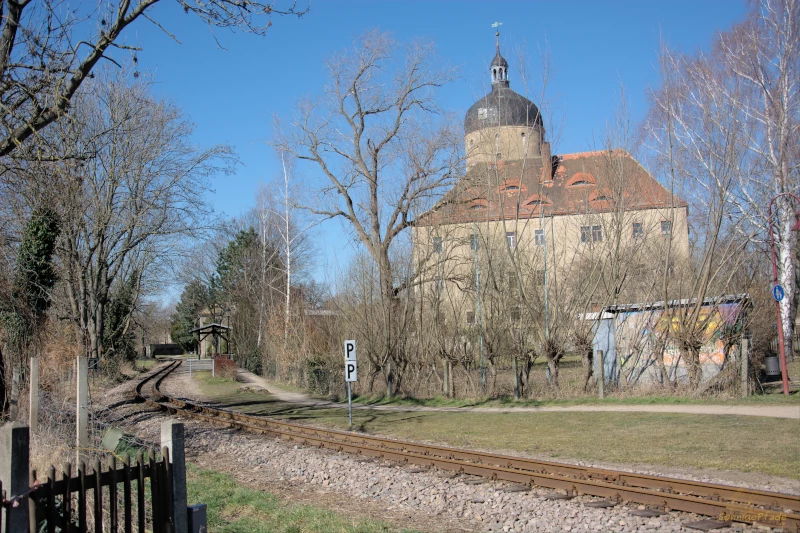
At Nebitzschen west of Mügeln the line splits: Either it goes to Kemmlitz or to Glossen. These are the current end points of the Döllnitzbahn. Unfortunately, both are just out in the middle of nowhere.
In Glossen, next to the terminus, is another small attraction – the start of a light railroad that provides access to an old quartzite quarry. However, according to the current timetable for the steam train rides with only 9 minutes stop in Glossen, there is no chance to see the light railroad in action. At the terminus, the locomotive will be re-coupled, i.e. placed at the train head, so that it can return to Oschatz.
Historic Döllnitz railway – small remnant of an important narrow gauge network
Unfortunately, it must be said, the current Döllnitz railway of the „Wild Robert“ is only a remnant of the former Mügeln narrow gauge railroads. These were put into operation in 1884 in the region of Döbeln – Mügeln – Oschatz by the Royal Saxon Railway. At Strehla, the narrow gauge tracks even reached the Elbe River and the Elbe harbor. This made the Mügel narrow-gauge line the only one with a direct connection to an Elbe port. The line in the opposite direction, i.e. from Mügeln westward, extended beyond Glossen, Wermsdorf as well as Mutzschen to the Mulde River at Trebsen. Mügeln with its large station was the main distribution point for the trains at this time. Bulk goods, industrial products, mail, passengers – everything was „re-sorted“ in Mügeln and sent on its way towards its destination.
At that time in the late 19th century, the new narrow-gauge railroad was an essential accelerator for the industrialization of the region. On the one hand, many people and thus workers could be transported to the newly emerging companies. On the other hand, of course, it was also a matter of transporting raw materials and products, i.e. accelerating trade. One of the most important bulk commodities was the mining and transportation of kaolin in several kaolin mines west of Mügeln, such as in Glossen and Kemmlitz.
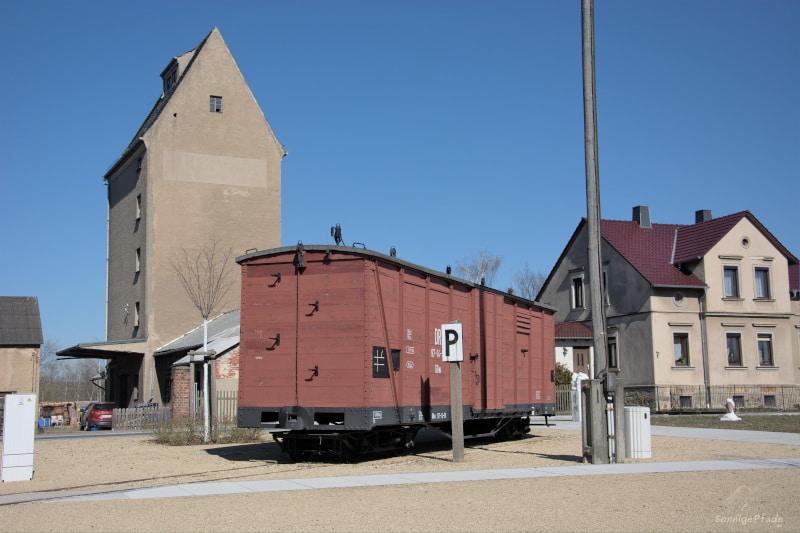
While a relatively large amount of freight was still transported in the GDR era (GDR .. former socialist east german demokratic republic), at least on a rump network, this shifted completely to the roads after accession to west germany in 1990. Only the transport of kaolin from the Kemmlitz open pit mine continued until the turn of the millennium. For this purpose, a transhipment facility for standard-gauge wagons was built at Oschatz station. It must be admitted that the different track gauges between narrow-gauge railroads and standard-gauge networks have always been an obstacle to smooth transportation. Whereas in some large cities with standard-gauge streetcar networks, freight streetcars were even able to provide rail transport to remote factories at night, the goods had to be either reloaded at the interfaces or at least the standard-gauge cars had to be pulled onto narrow-gauge roller blocks for transhipment onto narrow-gauge railroads. This made rail transport much less economical for narrow-gauge railroads. Some rolling blocks, partly also with old standard gauge freight cars, can still be seen in Mügeln at the station. A piece of railroad history…
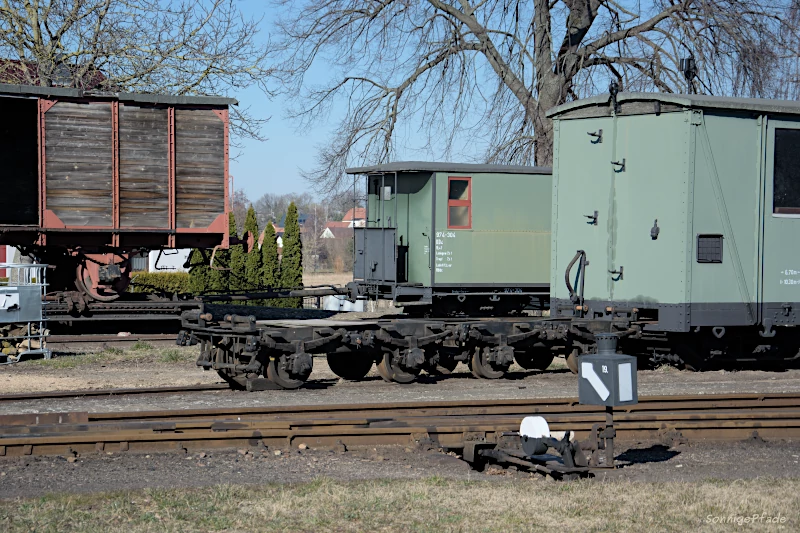
Tourist attraction with thin surroundings
However, it is very unfortunate that the Döllnitz Valley Railroad, as described above, ends today west of Mügeln more or less somewhere in the middle of nowhere. It is currently operated as a museum railroad and forms an important building block for the tourism of the region in south northern Saxony. In order to be able to operate the Doellnitz Railway more or less economically, the district of North Saxony decided after accession in 1990 to use it for school transport as well. Thus, subsidies for school transport flow into the operation of the railroad. During school days, of course, steam trains do not run; that would be far too time-consuming and expensive. Instead, trains run with diesel locomotives or diesel railcars.
It is really a pity that so far the continuation of the railroad line has not been relaunched to Wermsdorf. The branch to Kemmlitz was rebuilt about 20 years ago. But it is more interesting for railroad nostalgics.
Gap closure to Wermsdorf is missing today
Reconstruction of the connection to Wermsdorf, on the other hand, would be a real boost for tourism and thus also beneficial for the economic viability of the Doellnitz Railway. This would create a direct connection from the main railroad line Dresden – Leipzig near Oschatz to the baroque hunting lodge Hubertusburg, one of the most important baroque hunting castles in Europe. Many speak of the „Saxon Versailles“ at this castle. Since 2013, a start has been made to include Hubertusburg Castle in the exhibition – landscape of the Dresden State Art Collections, at least for the summer season, which attracts thousands of art lovers. Why should they not travel, at least in part, with the „Wild Robert“ narrow-gauge railway from the Oschatz train station?
In addition, there are many visitors to patients in the Hubertusburg clinics every day – in other words, many people who set off in the direction of Wermsdorf. The Döllnitz Valley Railroad, especially with steam locomotive trains on weekends, could thus form an important gap closure for tourism and an independent attraction in the Mügeln – Wermsdorf region in Saxony. Especially families with children looking for a varied offer in a limited area would thus find an exciting variety of industrial and transport history, technology, art, castles and palaces to nature experiences in the Wermsdorf forest, which could be optimally connected with the Doellnitz Railway.

The railroad station Mügeln and the „Geoportal Porphyrland – Kaolin Mining“
The passenger – station Mügeln, i.e. the station building, is no longer used by the narrow-gauge railroad „Wilder Robert“. In contrast to earlier times, the daily passenger volume of the Doellnitz Railway has decreased significantly and no longer needs a large station. Only recently, therefore, the station building was renovated and the Geoportal „Kaolin World of Experience“ was set up in the Mügeln Station . The exhibition informs about all connections with the valuable raw material from the region. In addition, depending on time and desire, one can go on several routes – partly also using the Doellnitz Railway for parts of the way or to reach a starting point.
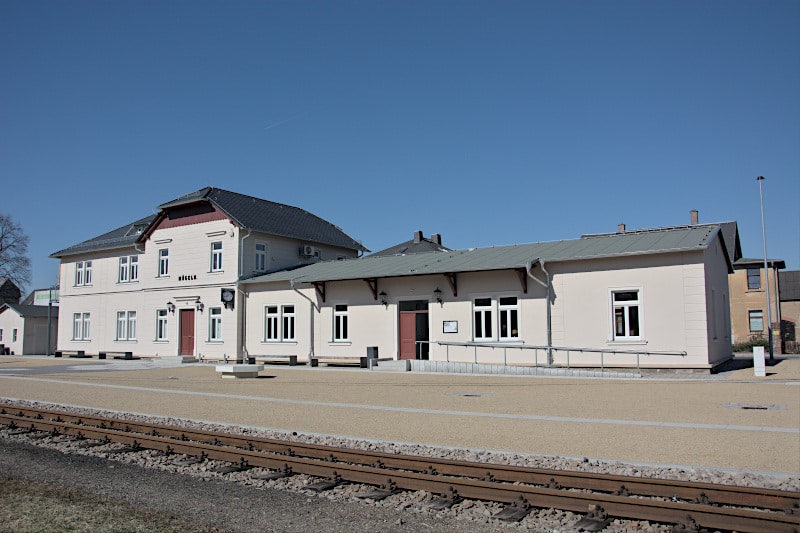
Kaolin – Geological exploration walk
Directly from the city center westward, the „Path to Kaolin“ leads along the idyllic Döllnitz floodplain to Altmügeln. There you will find the old church of St. Marien Altmügeln, which was first mentioned in written records as early as 1135. In it, among other things, is the only known peasant – epitaph (a described, shaped grave slab) in a church, which is dedicated to the local farmer Paul Wagner. Just behind the church, which interestingly is located „decentralized“ on the outskirts of the town, a path leads to the kaolin – open pit mine Schleben – Crellenhain. There, at the kaolin bench, a mining – tipping lorry, in which a bench was built, one can have a look at the extensive kaolin – opencast mining area. The „Path to Kaolin“ in Mügeln also passes by industrial plants of kaolin consumers such as the historic kiln – pottery and porcelain factory. Executed as a loop, the total length for the „Path to Kaolin“ near Mügeln is about 5.9km.
Kaolin is a weathered volcanic rock, which was thrown to the earth’s surface by huge volcanic activity about 290 million years ago. In other Geopark regions such as around Beucha near Leipzig, the Hohburg hills or the Schildberg hill near Schildau, this rock has been preserved as porphyry and was or is extracted in quarries. In the Cretaceous and Tertiary periods, parts of the porphyry weathered chemically and under subtropical climatic conditions and formed clay deposits with a thickness of 10 to 30m. Kaolin is used as clay for various processing such as stove brick and tiles, sanitary and electric ceramics or in particularly fine version for porcelain and faience – tableware.
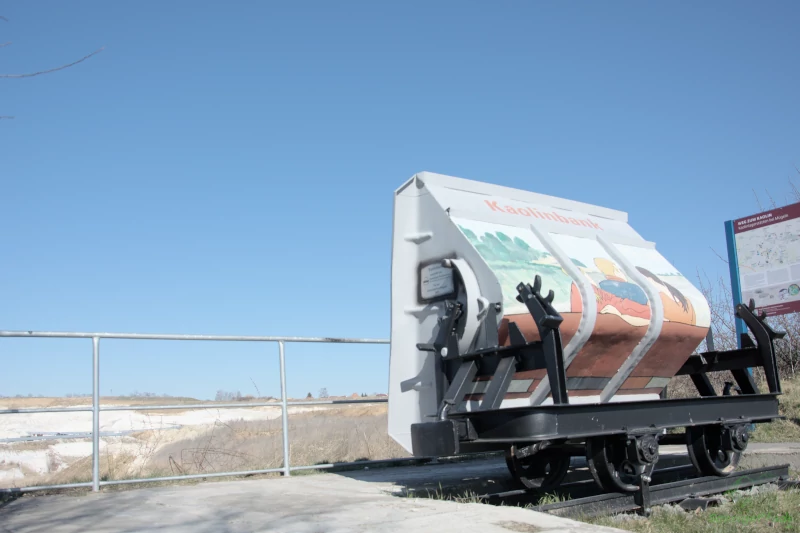
Hiking routes around the kaolin pits
In addition to the „Path to Kaolin“, three other large hiking or biking routes have been designated near Mügeln. These each lead along or near kaolin pits. In some cases, it is possible to use the Doellnitz Railway for sections of the route so as not to have to walk everything. These routes are called „Gröppendorfer Runde“ – with 19.3km the longest route, but until Glossen on the route of the Doellnitz Railway, „Sornziger Runde“ – 14.7km, this runs from Mügeln parallel to the Kemmlitz branch of the Doellnitz Railway and „Börtewitzer Runde“ – 12.2km, here Kemmlitz is the starting – and end point.
Museum of local history Mügeln – excerpts from the town history
In the old girls‘ school from 1834 at Schulplatz 2 (School square) Mügeln today offers a small museum of local history. It is open on Saturdays and Sundays from 2 – 5 p.m. – at least on the days when steam trains of the Doellnitz Railway are on the road. The exhibition offers some insights into the more than 1000 – year old town history of Mügeln. Especially the time since the industrialization with the construction of the Doellnitz Railway is presented and a part of the product range of Mügeln companies is shown. Until then, I was not so much clear what at all in Mügeln everything was and is produced! Fortunately, some of the companies have survived the period of deindustrialization of the former GDR – countries after accession to west germany, in contrast to many other East German companies. VARIA – school color boxes – who knows that they come from Mügeln? Even some of the more famous brands known in the West are actually VARIA products, only with a different label. Noble stove tiles for fireplaces and stoves, insulators for the electrical industry – all from Mügeln!
Adress: Schulplatz 2 at the post mile pillar
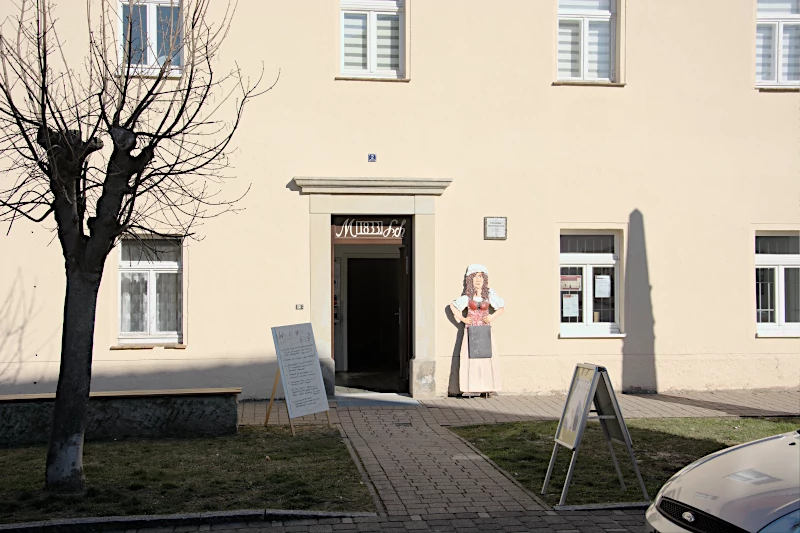
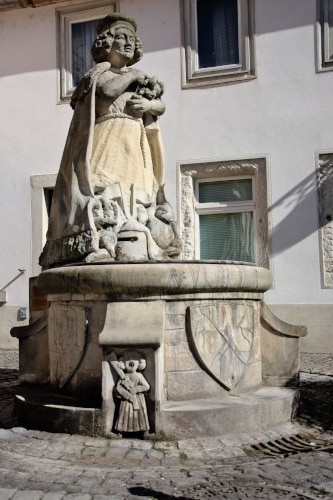
Besides, church music and musical life in general played a role in Mügeln. According to the presentation in the museum, the Mügeln region was a „Catholic enclave“ of the High Chapter of Meissen between the Protestant movement in Saxony, which the Electorate promoted. However, the friction between the ecclesiastical confessions was not necessarily discharged in conflicts in Mügeln, but in the promotion of church music and school education. As early as 1350 there was a well-known minnesinger Heinrich von Mügeln, who, with his poems of song, gave a local Walter von der Vogelweide. Rich choir life and active church music produced several nationally important artists who became effective in Saxony as cantors and musicians. Church music and other concerts are still occasionally held in Mügeln today.
Special exhibition of the photographer Gottlieb Münch
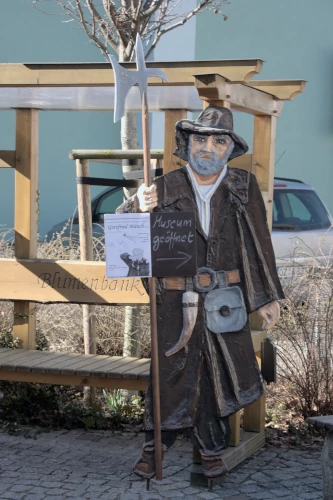
Museum of local history
Who is now on the way, can see in the museum of local history until probably the end of May 22 still an exhibition of photographs of the Mügeln local – photographer Gottlieb Münch. He was already since the 60s always with the camera on the way, if there was something going on in the region or at least the light was good. Thus, his photos document numerous weddings, work in Mügeln businesses, market scenes, jazz bands of the 60s live in concert, city views with castle and Doellnitz Railway, trips to the Baltic Sea and everyday events. High quality photographs with skillful play of light, shadow, sharpness and scene.
It is a stroke of luck that committed citizens of Mügeln were able to save the extensive photo archive from the bulky waste at all. Since the photographer Gottlieb Münch, who died in 2020, had no descendants, the whereabouts of the collection remained unresolved. Only when neighbors alerted the museum director of the Mügeln local museum to the eviction and imminent disposal, this treasure was secured.
Because the fund is extensive and so far only partially processed, there is a chance that in the future thematic photo galleries of Gottlieb Münch will enrich the exhibitions of the museum of local history of Mügeln again and again.
Cycling near Mügeln
Certainly, the kaolin routes can be partially explored by bicycle. I was at least in the area between Altmügeln and Glossen with the bicycle on narrow roads and without too much car traffic on the way.
Mügeln has also developed other bike routes. Three different bicycle tours have been designated as „Obstland – Radrouten“ (fruit country bike routes), which lead to the fruit-growing areas southeast of Mügeln near Dürrweitzschen and south of the A 14 motorway, as well as to Leisnig on the Freiberg Mulde river. The cycle routes are headed with „Obstland aktuell“ (fruit country now), „Geschichte des Obstanbaus“ (history of fruit farming) and „Spirituelles rund um’s Obst“ (spirit around fruit). Cyclists may note that the regulations on the limited alcohol level in public traffic according to road traffic regulations also apply on the third route.
Without extra designation as a cycling route, however, the connection to the Wermsdorf forest and to Wermsdorf as well as for long-distance cyclists the way to the Dahlener Heide can also be managed well without being exposed to car traffic on too many roads. (Cycle path recommendation: via Altmügeln, past the kaolin open-cast mine and then uphill to Seelitz, from there on to the Wermsdorf forest)
„Banking town“ Mügeln
For the sake of convenience and tourist attractiveness, Mügeln has been declared a „banking metropolis„. This is not so much about cash, stock prices or speculation, but about various benches as seating, distributed throughout the city center and especially in the parks of the Döllnitz floodplain and the Anger. Because „Bank“ in german means a money bank as well as a park bench. We have already talked about the „kaolin bench“ in a tipper lorry of the open-cast mine. In addition, there is the „school beginners‘ bench“ (a classic small school bench from grandmother’s times with a firmly screwed writing desk), the „Gänsebank“ (goose bench), a „Notenbank“ (bench of notes, notes means money bills and music notes), „Hausbank“ (house bench), „Feuerwehrbank“ (fire department bench), „Massagebank“ (massage bench), „Arme-Sünder-Bank“ (poor sinner’s bench) etc….. The current Mügelner BankenIndex currently shows a total of 37 banks/benches. Make yourself on a discovery tour, resting places are plenty because of the inflationary listing of banks/ benches for the city stroll.
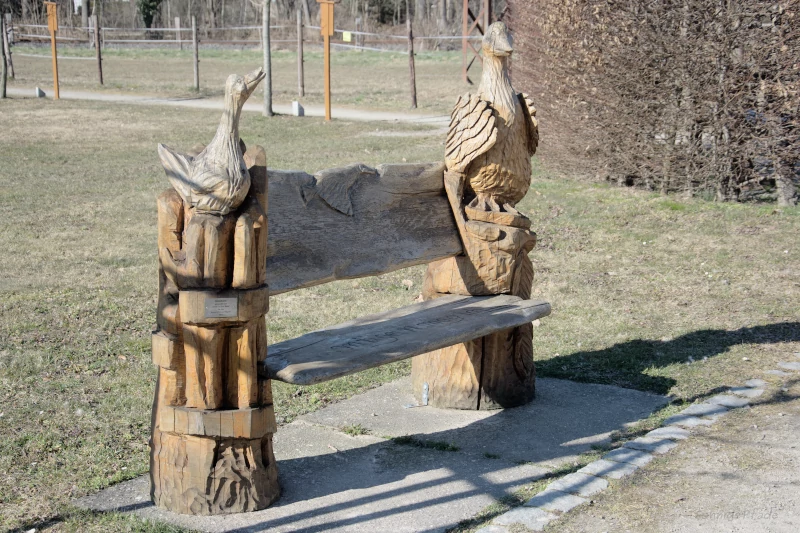
Excursion – Tips for Mügeln and the valley of the river Döllnitz
Gastronomic in Mügeln

The baggage coach is the dining coach! If you are traveling with the Doellnitz Railway, on one of the „Steam Train Days“, you can get a snack right on the train. During the longer stops at the end stations and at Mügeln station, the door at the baggage coach opens and coffee, tea, axle oil, sparkling wine and beer, fire department soda, possibly cake and something simple like Vienna sausage or bockwurst are sold there.
An organic snack is offered by the Bio-Cafe at Markt 6 (market square) in the „Gesundhaus“ (health house) during the usual opening hours. This store is also tourist information for Mügeln and sells books, natural cosmetics.
The restaurant Altmarkt 6 offers various home cooking and solid meals. There are even a few vegetarian dishes on the menu, which unfortunately is still not a matter of course in german rural communities.
If you are only looking for a simple meal in between, you will also find an Asian snack bar in Dr. Friedrichs – Straße (main street from the market to the train station). The selection is not so bad, on the menu are also some vegetarian offers partly with tofu. Of course, everything in the Asia Imbiß is for takeaway, but some tables and comfortable seats invite non-local guests to stay on site.
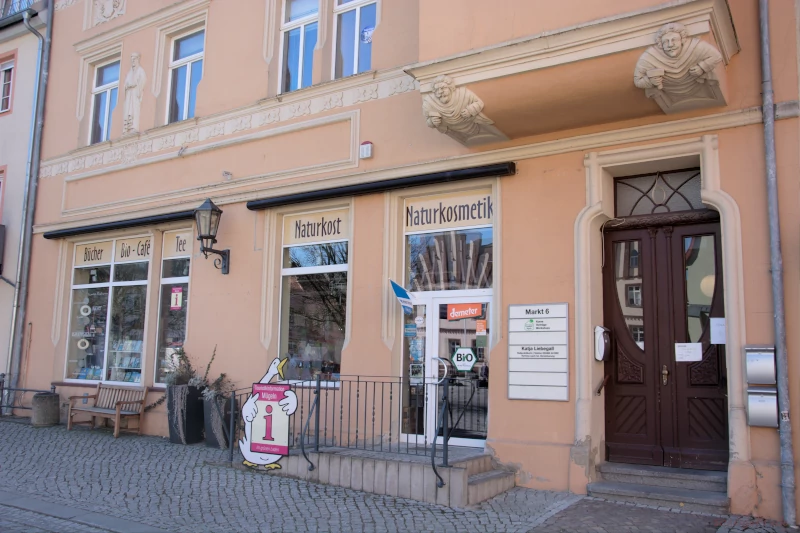

Weather in Mügeln
The steam trains of the Doellnitz Railway run in any weather on the scheduled days. So even in winter when it snows (especially nice are mulled wine – trips in Advent! or the spring trips, when the fresh green leaves break through in the Döllnitzaue). A small Mügeln – weather forecast for the next three days offers you the adjacent overview.
Journey to the Döllnitz – floodplain
The best way to get to Mügeln is by train*. The first station is Oschatz on the regional railroad line Leipzig – Dresden. There the Döllnitz Valley Railroad runs as a narrow-gauge railroad to Mügeln. The Doellnitz Railway can be used with a valid ticket from the MDV transport association, to which the narrow-gauge railroad also belongs. For the steam train trips on the weekends, however, a steam surcharge must be paid. In the week from Monday to Friday, the Doellnitz Railway is mainly used for school transport (note – different travel times during the Saxon school vacations!) and is operated with diesel drive or a combustion railcar.
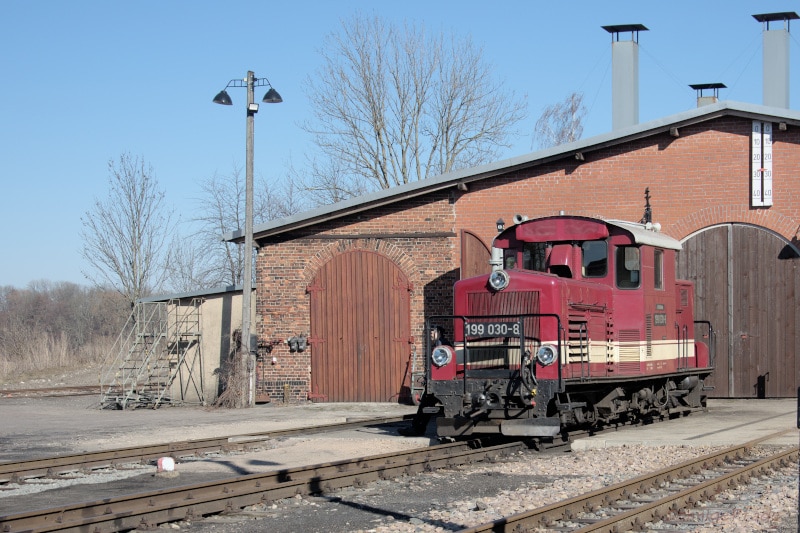
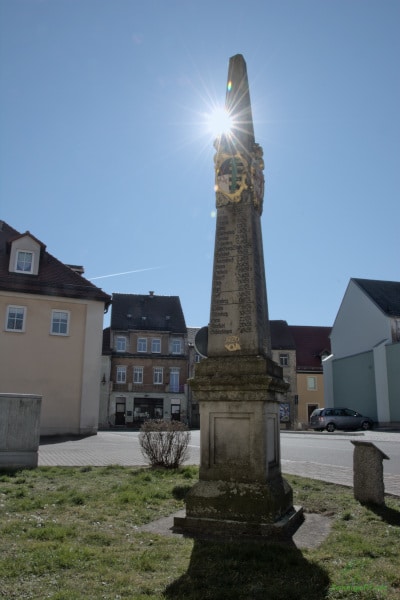
The steam trains do not run every weekend! About the steam train – days of the Doellnitz Railway informs the website (steam train – look for german „Dampfzüge“).
An alternative is the journey to the station Dahlen (Saxonia) on the same railroad line. From there, buses run Monday to Saturday as the so-called „Taktbus“ Dahlen – Wermsdorf – Mügeln. On Sundays, however, these buses do not run.
By car the way leads either over the motorway A14 Leipzig – Dresden to exit Leisnig or over the good old highway B6 to Lonnewitz near Oschatz. From the B169 (Döbeln – Riesa) highway there is also an exit at Ostrau in the direction of Mügeln. Nearest airport ist Leipzig – Halle (LEJ) at the mentioned motorway A14 near Leipzig. There is also a car hire station*.
The most beautiful way to get there by bike is through the Dahlener Heide via Dahlen and the Wermsdorf forest. Coming from the south, you can turn off the Elbe cycle path in Zehren and cycle via Lommatzsch to Mügeln. Coming from the north, you can leave the Elbe Cycle Path in Strehla or Belgern at the latest and ride through the Dahlener Heide.
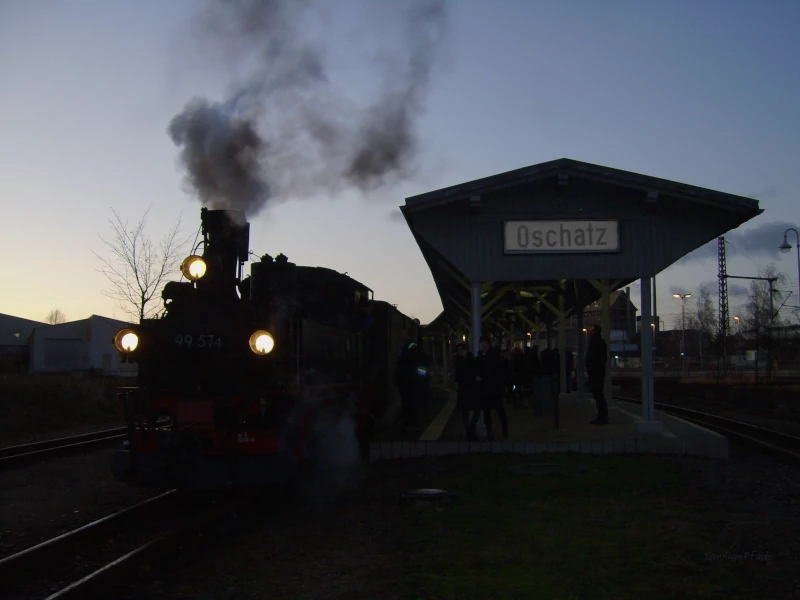
Already on the road in your mind? Steam up your friends and go!
If you liked the article about the Döllnitz valley – narrow gauge railroad, then visit the next steam locomotive – days and make the trip with the historic trains! And invite friends – best by sharing the link to the post in your social media channels. Thank you!
Note on * advertising links
The article contains links with *. These lead to online – stores or agencies. If you book something there, the „Sunny Paths“ blog receives a small commission to cover the technical expenses. For you nothing will be more expensive, because the commission is already taken into account by the providers in the price calculation.
